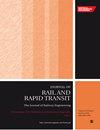磨削表面质量对轮轨副耐磨性和滚动接触疲劳性能影响的双盘研究
IF 2.1
4区 工程技术
Q3 ENGINEERING, CIVIL
Proceedings of the Institution of Mechanical Engineers Part F-Journal of Rail and Rapid Transit
Pub Date : 2023-06-27
DOI:10.1177/09544097231184000
引用次数: 0
摘要
对实验室控制磨削条件下制备的轮轨材料双盘试样的摩擦学行为进行了研究。设计并验证了实验室研磨装置,在表面质量和白色蚀刻层(WEL)的存在方面产生与现场相似的结果。测试样品在干燥和润滑条件下在双盘机器中进行评估。结果表明,不同的表面处理工艺会使表面处理参数和微观结构发生较大的变化,并影响样品的摩擦学响应。不同钢轨表面质量的摩擦磨损试验表明,润滑试验的磨损率降低了47.4%,干燥试验的磨损率降低了7.3%。仅适用于井眼厚度小于4 μm的情况。本文章由计算机程序翻译,如有差异,请以英文原文为准。
A twin-disc study of the role of the surface quality achieved by grinding on the wear resistance and rolling contact fatigue behavior of wheel/rail pairs
The tribological behavior of wheel and rail material twin-disc samples prepared under laboratory-controlled grinding operations was studied. A laboratory grinding device was designed and validated to produce similar results to those found in the field in terms of surface quality and presence of white etching layer (WEL). The test samples were evaluated in a twin-disc machine under dry and lubricated conditions. The results showed that the surface finishing parameters and the microstructure change greatly depending on the surface preparation procedure, and that such changes affect the tribological response of the samples. The wear rates of the tribological tests for the different rail surface qualities showed a reduction of 47.4% for the lubricated tests and 7.3% for the dry tests when the surfaces of the rail specimens were finished by grinding. This is only applied when the WEL thickness was less than 4 μm.
求助全文
通过发布文献求助,成功后即可免费获取论文全文。
去求助
来源期刊

CiteScore
4.80
自引率
10.00%
发文量
91
审稿时长
7 months
期刊介绍:
The Journal of Rail and Rapid Transit is devoted to engineering in its widest interpretation applicable to rail and rapid transit. The Journal aims to promote sharing of technical knowledge, ideas and experience between engineers and researchers working in the railway field.
 求助内容:
求助内容: 应助结果提醒方式:
应助结果提醒方式:


